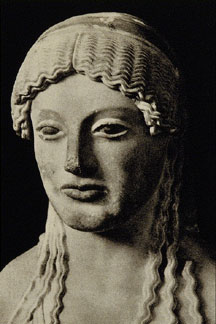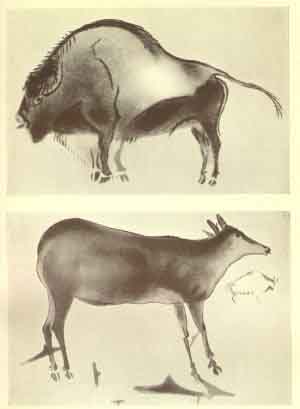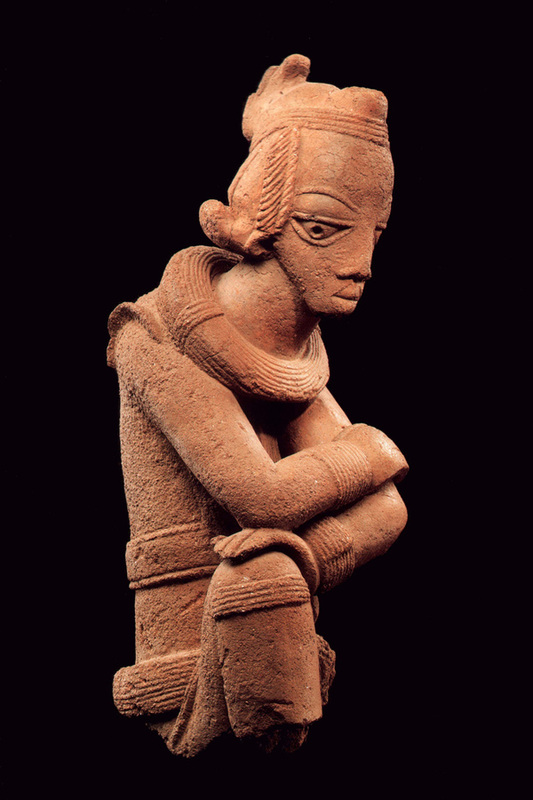Stylization In African Art - Culture - Nairaland
Nairaland Forum / Nairaland / General / Culture / Stylization In African Art (6837 Views)
The Uselessness Of White Wedding In African Societies!!! / Abstract Or Stylized African Art In Pictures / African Art (2) (3) (4)
| Stylization In African Art by tpia1: 4:40am On Apr 24, 2011 |
much of african art tends to be intensely stylized, with emphasis placed on certain anatomical features of the body, in contrast to the actual proportions. And vice versa. My guess is such representations foster an esoteric interpretation on the part of the viewer and also help apply a specific focus on the context in which they're intended to apply. |
| Re: Stylization In African Art by Nobody: 4:54am On Apr 25, 2011 |
with a few exceptions in some places, much of african art tends to be feature this stylization, which in some way serves as a conduit to the spiritual cosmos that is central to traditional african beliefs. |
| Re: Stylization In African Art by tpia5: 8:35pm On Dec 25, 2013 |
African art is a term typically used for the art of Sub-Saharan Africa.Often, casual observers tend to generalize "traditional" African art, but the continent is full of people, societies and civilizations, each with a unique visual culture. The definition may also include the art of the African Diasporas, such as the art of African Americans. Despite this diversity, there are some unifying artistic themes when considering the totality of the visual culture from the continent of Africa. The term African art does not usually include the art of the North African areas along the Mediterranean coast, as such areas had long been part of different traditions. For more than a millennium, the art of such areas had formed part of Islamic art, although with many particular characteristics. The Art of Ethiopia, with a long Christian tradition, is also different from that of most of Africa, where Traditional African religion (with Islam in the north) was dominant until relatively recently. Most African sculpture was historically in wood and other organic materials that have not survived from earlier than, at most, a few centuries ago; older pottery figures can be found from a number of areas. Masks are important elements in the art of many peoples, along with human figures, often highly stylized. There is a vast variety of styles, often varying within the same context of origin depending on the use of the object, but wide regional trends are apparent; sculpture is most common among "groups of settled cultivators in the areas drained by the Niger and Congo rivers" in West Africa.[2] Direct images of deities are relatively infrequent, but masks in particular are or were often made for religious ceremonies; today many are made for tourists as "airport art". African masks were an influence on European Modernist art,which was inspired by their lack of concern for naturalistic depiction. http://en.wikipedia.org/wiki/African_art 1 Like 1 Share |
| Re: Stylization In African Art by tpia5: 8:37pm On Dec 25, 2013 |
@ bolded naturalistic art is art which depicts objects as close as possible to their natural form. in stylization, different parts may be exaggerated or minimized depending on emphasis. |
| Re: Stylization In African Art by tpia5: 8:43pm On Dec 25, 2013 |
[img]http://mathildasanthropologyblog.files./2008/04/nokboy.jpg[/img] this nok sculpture, for example, has highly stylized facial proportions. the chin and cheekbones are elongated, as are the nose, lips and eyes,which also follow the triangular pattern of the face. |
| Re: Stylization In African Art by Onegai(f): 1:52pm On Dec 27, 2013 |
Please don't exactly believe all Wikipedia tells you, as I've seen western "experts" get it wrong, yet publish it till it's believed. I collect antique Nigerian art and try to do research on my buys, as well as being an artist. The stylizations are our mark, just as lack of Western Perspective is the mark of most Asian art. The stylization was to give emphasis onto what we would now call the Focal point, of the piece. Please take a look at some of my pictures below to see this. This yoruba statue of a warrior and his horse, depicts the warrior as twice the size of the horse, because he is the focal point. In most yoruba statues, the faces resemble the bone structure of yoruba people (wide cheekbones, short noses, tribal marks). Same with Bini statues (I'll post my collection later). www.alizarene..com
|
| Re: Stylization In African Art by tpia5: 5:51pm On Dec 27, 2013 |
Please don't exactly believe all Wikipedia tells you, as I've seen western "experts" get it wrong, yet publish it till it's believed its not a wikipedia thing, art generally can be analyzed by the amount and type of stylization used to depict the subject matter. your picture still shows stylization because the artist wants the focus to be on the rider, who is made to seem larger than the horse, whose size is minimized. So you are not necessarily contradicting wikipedia in this instance. greek art, which aimed to be as naturalistic as possible, generally followed actual body and facial proportions closely. eg    this was to make the art look more realistic and relatable, and since those were the "photographs" back then in that society. as opposed to highly stylized art which is not meant to be relatable per se, but more of functional for certain purposes, not the general public. |
| Re: Stylization In African Art by tpia5: 6:01pm On Dec 27, 2013 |
In most yoruba statues, the faces resemble the bone structure of yoruba people yoruba people do not have one facial structure, but many. the ife sculptures are modelled after specific ife people of that time, imo. (wide cheekbones, short noses, tribal marks) most traditional african sculptures feature the same, depending on the particular culture. The stylizations are our mark, just as lack of Western Perspective is the mark of most Asian art. art from which part of asia? chinese art is different from indian art, for example. |
| Re: Stylization In African Art by tpia5: 6:33pm On Dec 27, 2013 |
the thread is about african art but i'll digress a little. in prehistoric cave art, animals were often depicted with smaller heads relative to body size. This form of stylization when drawing facial structures, may have been because the society was a hunting one, and animal meat was important. eg   |
| Re: Stylization In African Art by tpia5: 10:20pm On Dec 27, 2013 |
back to africa: this is a prehistoric rock drawing of an elephant.  the body proportions are not so exaggerated per se, this could be because an elephant would be much more difficult to hunt due to its size. compare to this drawing of a smaller animal  the head once again is relatively small, and emphasis is on the body. |
| Re: Stylization In African Art by tpia5: 10:21pm On Dec 27, 2013 |
i have not checked the likely time frames for both photos. |
| Re: Stylization In African Art by tpia5: 10:30pm On Dec 27, 2013 |
prehistoric painting of a rhino from southern france [img]http://2.bp..com/-Vk5mK4qKV6w/TdsLPLkuYYI/AAAAAAAABFY/ejmM_oXBxZc/s640/634x375chauvet-cave-rhino-painting_2351.jpg[/img] the head is given more prominence and the horn in particular is elongated for emphasis. |
| Re: Stylization In African Art by itstpia1: 1:14am On Oct 10, 2014 |
. |
| Re: Stylization In African Art by itstpia1: 6:13am On Oct 17, 2014 |
tpia5: in addition, nok art places emphasis on straight facial lines. the jaw is clearly defined and almost always triangular. not sure if this is supposed to depict eloquence or something else. some nok sculptures also have an aura of calm, occasionally the figures are looking down and in a reflective (pensive) mood. eg:  ** not sure of the date for this terracotta** |
| Re: Stylization In African Art by tpiadotcom: 5:25pm On May 04, 2015 |
tpia5: |
| Re: Stylization In African Art by tpiadotcom: 5:26pm On May 04, 2015 |
with a few exceptions in some places, much of african art tends to be feature this stylization, which in some way serves as a conduit to the spiritual cosmos that is central to traditional african beliefs. |
| Re: Stylization In African Art by tpiadotcom: 5:26pm On May 04, 2015 |
tpia1: |
| Re: Stylization In African Art by tpiadotcom: 3:47pm On May 22, 2015 |
. |
| Re: Stylization In African Art by tpiander: 2:46am On Sep 17, 2015 |
 |
| Re: Stylization In African Art by tpiander: 10:24pm On Oct 02, 2015 |
tpia5: very interesting play on proportions |
| Re: Stylization In African Art by amayodimeji: 10:29pm On Jan 01, 2016 |
I agree with you, consequent observation of the past artistic works of african artist is genuine, the ori olokun head that was used in the past by the people of ife and benin. during the corronattion of a new king at benin, a naturalistic head is been sent for from ile ife until igoega was sent to ife to learn the work, the head is percieved as the presence and approval of the king. Igoega,s family in benin city till today still make naturalistic art in metal..Artists are commissioned to create their portrait, u see the benin royal plaques, not stylised...I call them lovies,#photography in africa even before the modern day camera advent. |
| Re: Stylization In African Art by amayodimeji: 10:38pm On Jan 01, 2016 |
Onegai:...I so concur,but I will like to ask you this, are the striation (ethic mark) are the naturalistic or stylized?... |
| Re: Stylization In African Art by Onegai(f): 7:00am On Jan 02, 2016 |
amayodimeji: It depends on the era and the origin. For the Bini ones, it was probably naturalistic because Bini people tended to value those markings as signs of beauty. They would use a broken edge of a calabash to scrape their skin. That motif is now replicated on modern traditional menswear/attire in Bini culture (by order of the Oba). |
| Re: Stylization In African Art by amayodimeji: 1:16pm On Jan 02, 2016 |
itstpia1:...terracottas are said to have dated as early as 4000bc even more, the ones from jos plateau is older |
| Re: Stylization In African Art by amayodimeji: 1:25pm On Jan 02, 2016 |
Onegai:.....the extanct royal chiefs of benin still ve this marks on their face...so let me ask, if the ethnic marks were detailed on them, what do you think of the line drawn vertically along the ori olokun bronze heads from ife, are they ethnic striations or crown fringes made with beads which is covering the kings face...? Seems the people today dnt ve these marks |
| Re: Stylization In African Art by amayodimeji: 1:34pm On Jan 02, 2016 |
Actually, these stylized features are not synonymous to the Nok sculpture alone, I ve rrasons to believe that this art belong to Africa at large not just the Nok culture area... |
| Re: Stylization In African Art by tpiar: 5:12pm On Feb 23, 2016 |
amayodimeji:  |
| Re: Stylization In African Art by tpiar: 6:40pm On Mar 26, 2016 |
amayodimeji: that's a bit difficult to tell. The Obalufon head does not have those markings, so it's possible they are stylized elements added to the art.  2 Likes 1 Share |
| Re: Stylization In African Art by tpiar: 6:44pm On Mar 26, 2016 |
 This sculpture shows traces of red paint around the eyes. The paint (use unknown), changes the expression of the statue somewhat, giving it a less peaceful or relaxed appearance and more of a fiercer one. It's possible the paint (if from the time the sculpture was made), was for a ceremonial (or ritualistic) purpose, hence the need for a different expression than the original carving.  |
(1) (Reply)
The Past Aare Ona Kakanfo Of Yorubaland... / Oriaku? / Papua New Guinea President Went To UN Meeting In Newyork On Traditional Dress.
(Go Up)
| Sections: politics (1) business autos (1) jobs (1) career education (1) romance computers phones travel sports fashion health religion celebs tv-movies music-radio literature webmasters programming techmarket Links: (1) (2) (3) (4) (5) (6) (7) (8) (9) (10) Nairaland - Copyright © 2005 - 2024 Oluwaseun Osewa. All rights reserved. See How To Advertise. 47 |